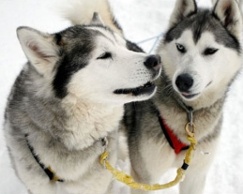
I am a fan of Ray Coppinger's theory of domestication that names flight distance as the determining factor of natural selection for the dog. Briefly, Coppinger says that when humans began to live in group settlements (anthropologists disagree on whether this was 15 or 30 thousand years ago--that is not my subject here), they began to generate group trash piles. Food scraps and other types of waste drew the attention of local wolves.
Those wolves who were brave enough to go near the settlement could get the scraps in the dump area. As a result, they came close to humans (or our predecessors). These wolves were distinguished from their less bold brethren by FLIGHT DISTANCE: If you are willing to chance it and come close, you get food. Those who began to live closer to humans were demonstrating NATURAL selection--not artificial selection. As their population increased, those wolves who hung out together near the human areas ended up breeding together. This became the process of selection by tameness, and the process continued to refine itself until there was an animal distinct from the wolf, and that was the dog.
This first step in domestication came to mind today as I was working with two young puppies who don't know me yet. As I have said a million times, if you want a dog to come, do not go toward the dog. So I began to pitch food between the puppies and myself. One puppy came in for the prize. Over and over she got the resource. Of course I kept working until both puppies were at ease with me, but it reminded me of the power of flight distance even in our entirely domesticated companions.
If you want to learn more about domestication, I highly recommend Ray and Lorna Coppinger's work. Their books are available on Amazon.
Cheers,


